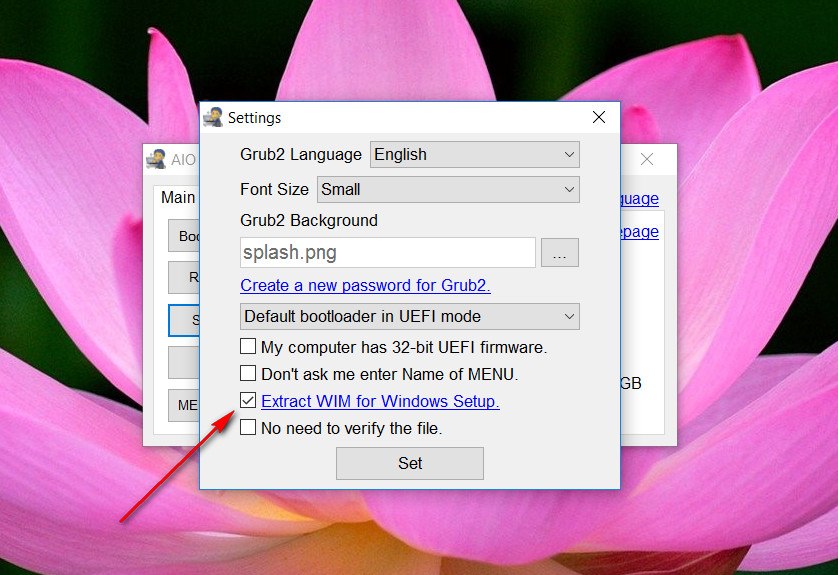
- #WINDOWS 10 BOOT MENU MOUNTING WIM HOW TO#
- #WINDOWS 10 BOOT MENU MOUNTING WIM WINDOWS 10#
- #WINDOWS 10 BOOT MENU MOUNTING WIM ISO#
- #WINDOWS 10 BOOT MENU MOUNTING WIM WINDOWS#
#WINDOWS 10 BOOT MENU MOUNTING WIM ISO#
Any help would be greatly Appreciated.Īlso, when I tried just running the setup from the ISO that was on the BOOTCAMP partition (instead of pointing it to the flashdrive), it gave me the same error.
#WINDOWS 10 BOOT MENU MOUNTING WIM WINDOWS#
I have even tried using the Windows Media Creation tool to make a USB drive, and copied the BootCamp5 contents over to it, but when I try to load the AutoUnattended file, nothing happens, not even a new setup window. I have used older versions of the Windows ISO on the flash drive, but every time I start the setup I get the same error. First off, the USB and the Bootcamp partition are ExFat, so they won't have the 4gb limit. It says "0x8007000D windows cannot open the required file D:\sources\install.wim make sure all the files required for installation are available…" I have tried several things to fix this problem. Right after I type the command, I get the error. Then, you type in the command that points to your USB flash drive to initiate the setup.
#WINDOWS 10 BOOT MENU MOUNTING WIM WINDOWS 10#
From the guide mentioned, it seems you boot into the Windows 10 setup that you loaded to your Bootcamp Partition.

#WINDOWS 10 BOOT MENU MOUNTING WIM HOW TO#
Well now at least you have an idea what is happening.I am following the guide here How to install Windows 10 into a 2011 iMac without using the Boot Camp Assistant, an optical (DVD) drive or third party tools? and everything appears to work until I actually install Windows 10. You could of cause integrate MDT with SCCM and the just use the “Create boot image using Microsoft Deployment” wizard found under and all these steps would be automatically executed. Should you need to make further changes to the boot.wim, just copy the winpe.wim from C:\WinPEx86\source\winpe.wim to C:\WinPEx86\winpe.wim and start from step 2. Point to the newly created Boot.wim and follow the wizard. Right click Boot Images and choose Add Boot Image. Import the boot.wim into Configuration Mgr. imagex.exe /export C:\WinPEx86\winpe.wim 1 C:\WinPEx86\boot.wimĨ. This step is necessary to reduce the image footprint (reduce the size) peimg.exe /prep C:\WinPEx86\mount\windows /f (this will make the Boot image ready for SCCM)ħ. Finalize the boot image using the following command: Xcopy C:\WinPEx86\winpe.wim C:\WinPEx86\source\winpe.wim /y (this will be the image to use next time you want to customize)Ħ. Imagex /unmount /commit C:\WinPEx86\mount Save a copy of your customised Boot.wim, as the boot.wim used for SCCM will be closed for updates! Copy Trace32 to C:\WinPEx86\mount\windows\system32 (tool for viewing LOG files – which is a must have)ĥ.

This step is optional and you could add any number of files and programs. peimg.exe /install=*Fonts* C:\WinPEx86\mount\windows (support for ASIA font types)Ĥ. peimg.exe /install=*MDAC* C:\WinPEx86\mount\windows (support for Database access – mandatory if using MDT DB) peimg.exe /install=*HTA* C:\WinPEx86\mount\windows (support for HTA) peimg.exe /install=*XML* C:\WinPEx86\mount\windows (support for XML – mandatory for SCCM) peimg.exe /install=*WMI* C:\WinPEx86\mount\windows (support for WMI – mandatory for SCCM) peimg.exe /install=*Scripting* C:\WinPEx86\mount\windows (support for. Install optional components (Scripting, WMI and XML are required to perform SCCM OS deployments – so they must be installed) imagex.exe /mountrw C:\WinPEx86\winpe.wim 1 C:\WinPEx86\mountģ. Mount the boot image to a temporary directory. Type COPYPE X86 C:\WinPEx86 (this is for 32bit, for 64bit change x86 to amd64)Ģ.

Go to and start Windows PE Tools Command Prompt Use (WAIK) To create a WinPE 2.1 boot image NOTE - Before you start please read the last two lines in this guide (describes the easy way to do this!!)ġ. If that's the case you will have to make a custom boot image.īeneath is an 8 step guide on how to do that… Well you might have to inject some NIC and Storage drivers, but that's properly it!Ī problem you might run into though, is lacking functionality of that WinPE build, like no HTA, MDAC/ADO support etc, or you might need to ad a “Custom media hook” to run a script prior to starting the task sequence.

Normally you can just use the boot image supplied with SCCM (a WinPE 2.1 wim, taken from WAIK and placed in \\”SiteServer”\SMS_”SiteCode”\osd\boot\”architecture”\boot.wim), with out any further considerations. When using System Centre Configuration Manager for OS deployment you always use WinPE as your boot media/environment for deploying the actual image…


 0 kommentar(er)
0 kommentar(er)
